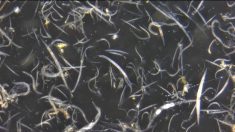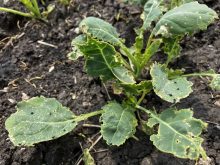Clubroot has been found in two Saskatchewan canola fields a reminder why Manitoba farmers need to stay on guard for the disease that can decimate not only canola but cole crops.
It moves with the soil, and as we all know, you can move soil really easily without realizing you are, said Anastasia Kubinec, an oilseed specialist with Manitoba Agriculture, Food and Rural Initiatives (MAFRI).
Slime mould
Clubroot, a slime mould that produces galls on the roots of susceptible plants, was first found in Alberta canola in 2003 near Edmonton. Since then it has spread to more than 600 fields and as far south as Lethbridge.
Read Also

CUSMA access key among other trade noise: Seeds Canada panel
Seeds Canada conference panelists say Canada needs to stay focused and wait as U.S. trade and tariff chaos develops, and a Canada-U.S.-Mexico Agreement review looms
Oct. 4 SaskCanola announced two canola fields in north-central Saskatchewan were infected.
The confirmation of clubroot in Saskatchewan although extremely unfortunate is predictable given the nature of the disease and its eastward movement, SaskCanola chair Brett Halstead said in a news release. SaskCanola has understood this possibility for some time and invested close to $1 million in levy funding on research programs that have focused on clubroot prevention and management, including the purchase of new detection equipment for the provincial lab.
Farmers who see premature ripening in their canola fields or a yield loss in part of a field should dig up some plants and examine their roots, Kubinec said.
Don t just assume it s water sitting there or a miss or sclerotinia, she said.
If you start seeing funny things call MAFRI.
MAFRI investigates at least six fields a year suspected of having clubroot.
We (also) do a disease survey where we check 160 fields a year randomly for clubroot, Kubinec said. We are out there checking. At this point knock on wood we haven t found it, but potentially we might in the future.
First step
The first step in dealing with the disease, which can cut canola yields in half, is correctly identifying it. Then farmers need to avoid moving soil from infected fields. That means properly cleaning field equipment, vehicles and even footware. Water can also move soil and the disease.
Clubroot is an obligate parasite, which means it can t complete its life cycle without a living host. Disease spores can remain viable in the soil for long periods. Farmers should only grow canola in infected fields once every five years or less frequently if the spore count in the soil is heavy.
When canola is seeded in a previously infected field the farmer should plant a clubroot-resistant variety, Kubinec said. Several companies offer them.
They seem to be performing very well, she said. The one hiccup is its single-gene resistance for all these varieties so if it s overcome, it s back to the drawing board.
It s also important to control weeds, which can be infected by the disease, including wild mustard, shepherd s purse and stinkweed.
If clubroot gets to Manitoba, the province s high-value vegetable industry is at risk too. Cole crops including, broccoli, cauliflower, cabbage and rutabaga are susceptible, Kubinec said.
Symptoms
Although clubroot has not been detected in Manitoba on a commercial scale, a low-level infection was found in a canola nursery in 2005.
The first report of clubroot in Manitoba occurred in the late 1920s on rutabaga, followed by anecdotal observations of the disease in market garden vegetables in the mid-1980s, MAFRI s website states.
Above-ground clubroot symptoms suggest the plant is under water and nutrient stress.
Premature ripening is another symptom, the website says. Where infection has occurred individual roots may have spherical to elongated swollen portions often club shaped. In the initial stages of plant development the galls are firm and white inside. Later they become brown and decompose. When removed from the ground the stem may detach from the club, leaving clubbed roots in the soil.
Hybridization nodules, are small, rounded structures that may be present at root nodes. While not common, they might be mistaken for clubroot.
The inside of a clubroot gall is spongy or marbled, the site says. Hybridization nodules appear as healthy roots, of uniform texture and colour and don t decompose.
Herbicide damage, which may cause thickening of roots, may also be misidentified as clubroot galls.



















